Marie-Pièrre Astier, an art restorer, spent the whole of August, 1987, working in the Museum of Sacred Art in the Seminário de S. José.
Last November she wrote to us recounting her impressions: "I hope to return to Macau to impress upon the authorities the need to establish a beautiful Museum of Sacred Art. There ought to be windows capable of protecting the items from the rays of the sun. In their present state they will not last for more than twenty to thirty years.
It is a tremendous pity! There are no other works of art like these in the Orient. The woman with her hands clasped in prayer is one of the most precious objects in Macau: it is a rare colonial-style image. For me, discovering it was so exciting that I would like to convey this to the government and make them decide to take care of it."
Let us turn to the restoration work which she carried out, following the detailed report which she submitted.
JESUS WITH TWO NAILS IN HIS BREAST
This is a wooden statue, 142cm high, which is believed to date from the turn of this century. It was carved in one piece from the trunk of a tree. The hands, clasped in prayer, were carved and joined to the chest by the forearms.
A split in the wood runs down the right side of the body and, along with the joints between the hands, forearms and arms, had been filled with plastic during earlier restoration work at the turn of the century.
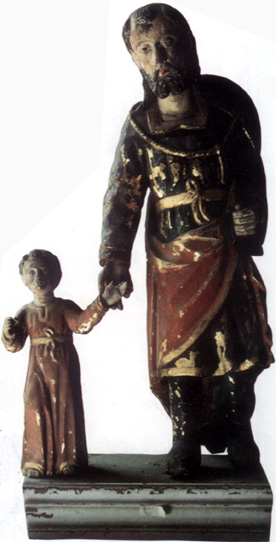 "St. Joseph with the Infant Jesus" - Two wooden statues (height 72cm), beginning of the XVIth Century.
"St. Joseph with the Infant Jesus" - Two wooden statues (height 72cm), beginning of the XVIth Century.
The excessively heavy coat of paint from its most recent restoration had dried up and was flaking away, revealing the original polychrome of the wood itself.
The statue must have been painted at least twice. For example, Jesus' robe was originally painted a pale Prussian blue, then a chestnut brown with some gold leaf and now it is white.
Whenever possible, Marie-Pièrre Astier tried to respect the original polychrome; she cleaned and filled the cavities; she cleaned the splinters and flaking from the last restoration and filled everything including a large cavity on the right shoulder. The left heel was also joined onto the foot.
Six coats of coloured enamel ensured the safe passage of this statue from the XIXth to the XXth Century.
The sculptor who created this image was someone deeply convinced of his faith as is reflected by the religious ecstasy of Jesus' hands clasped in spiritual contemplation.
ST. JOSEPH WITH THE INFANT JESUS
These wooden figures, 72cm high, with their serene expressions date from the early XVIth Century.
They were each carved out of a single block of wood. St. Joseph's hand hangs free by his side holding that of the Infant Jesus. Both statues were heavily and tastelessly painted in opaque colours at the turn of the century.
Dessication had made the whole painted surface look dry and hard. The final two fingers of St. Joseph's hand had disappeared, most probably due to pressure from the hand of Jesus. Both statues have lost their characteristic symbols (their staffs?). The figures stand, somewhat unsteadily, on what is probably not the original base. Last of all, the left hand and foot of Jesus were loose and shaky.
In the restoration work, Marie-Pièrre Astier treated the two statues as objects of art rather than objects of worship. She scraped away the heavy layers of paint until the gilded polychrome of a former restoration became visible.
The perfect split which ran right down the statue of St. Joseph was opened, filled in and then covered with a fibrous material in preparation for the gilding. This was not the only instance of this kind of repair job in the group.
Both statues were fully gilded. Round the collar of St. Joseph's robe, possibly the original polychrome, there were some traces of a white pattern on the gilding. In her use of gold leaf, Marie-Pierre Astier tried to maintain the original visual character of the sculptures.
These statues have been classified as belonging to the XVIth Century. Out of the heavy layers of paint which had been applied in restortion work over the last century, a statue carved with love and devotion became visible. The ears, intricately carved, seem to be listening just as the nose appears to be breathing. The artistry contained within this pair of figures has a seductive effect on the observer.
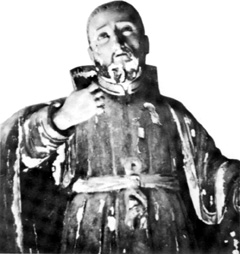
ST. FRANCIS OF BORJA
This XIXth Century statue of lightly coloured wood is 63cm high. The hands were carved separately and could be fitted onto any statue of the period. In his left hand, St. Francis holds a wooden skull and from the position of his right hand it seems that something, perhaps a staff, is missing.
The statue was carved and then painted, decorating the borders of his mantle and cassock with gold leaf. His glass eyes contemplate Heaven with an expression of adoration.
The sole coat of paint had dried out and was flaking and insubstantial, leaving the plaster and the wood itself visible. A wooden peg which had been inserted in the forearm was jutting out.
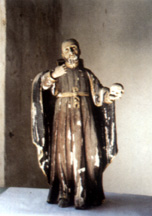
"St. Francis of Borja" - Wooden statue (height 63cm), XIXth Century.
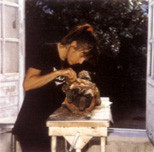
Marie-Pièrre Astier in the Seminário de S. José; restoration work on statue of St. Joseph
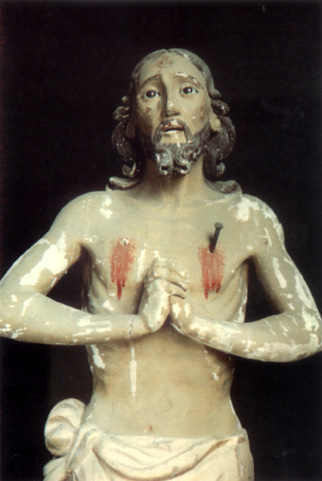
"Jesus with two nails in his chest" - Wooden statue (height 142cm), end of the XIXth Century or beginning of the XXth Century.
The left hand had been roughly glued to the forearm and both on this and the right hand all fingers, with the exception of the left pinky which must have been joined to the palm of the hand, had disappeared.
In order to preserve the semblance of a XIXth Century statue, the restorer applied liquid adhesive to strengthen the parts which had been repaired. All the bare patches on the painted surfaces were also filled in and likewise the crevices and cracks.
All the fingers were recast and joined to the palms of the hands. Finally, the statue was dressed in three coats of paint to restore it to the chromatic intensity it had in the XIXth Century.
This statue is the last in a line of wooden sculptures carved by generations of fine craftsmen. Sadly, from the beginning of this century the art of sculpting religious images in wood gave way to plaster cast statues.
*Internationally renowned historian, specializing in the History of Macau, the Portuguese and the Church in the Orient, the author of over one hundred and fifteen books.
Member of the Portuguese Academy of History and several international organizations and institutions, ie. the International Association of Historians of Asia.
start p. 55
end p.